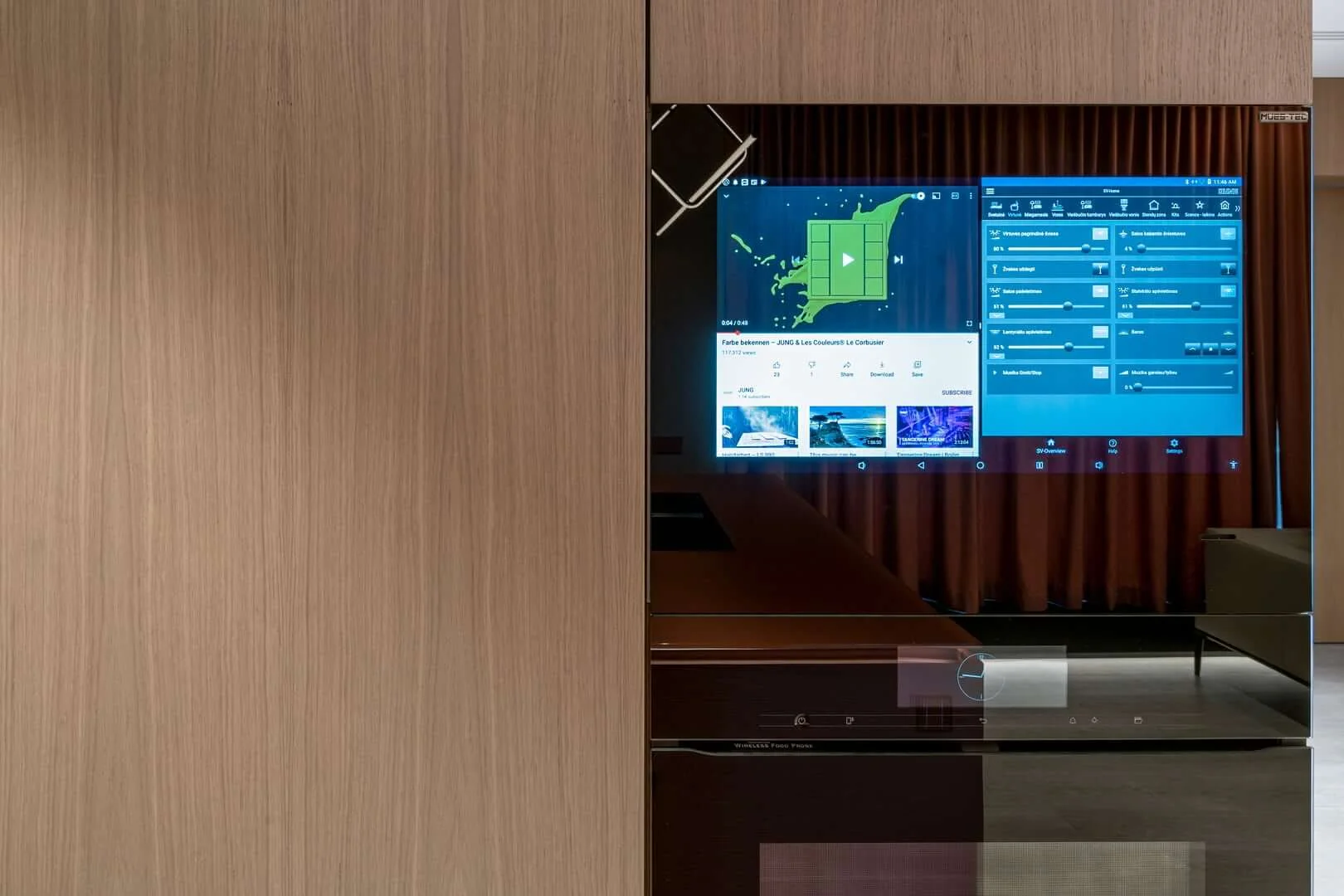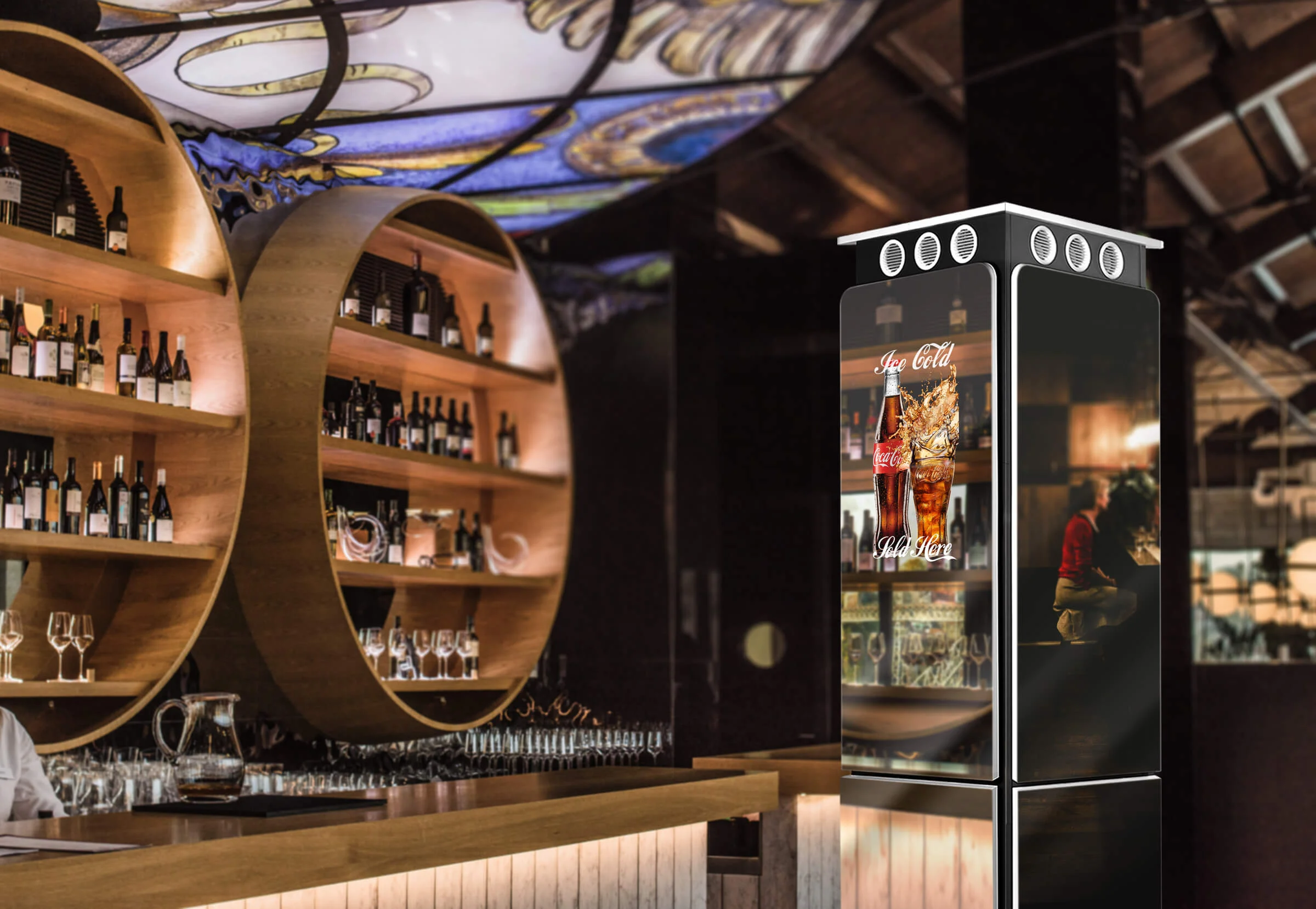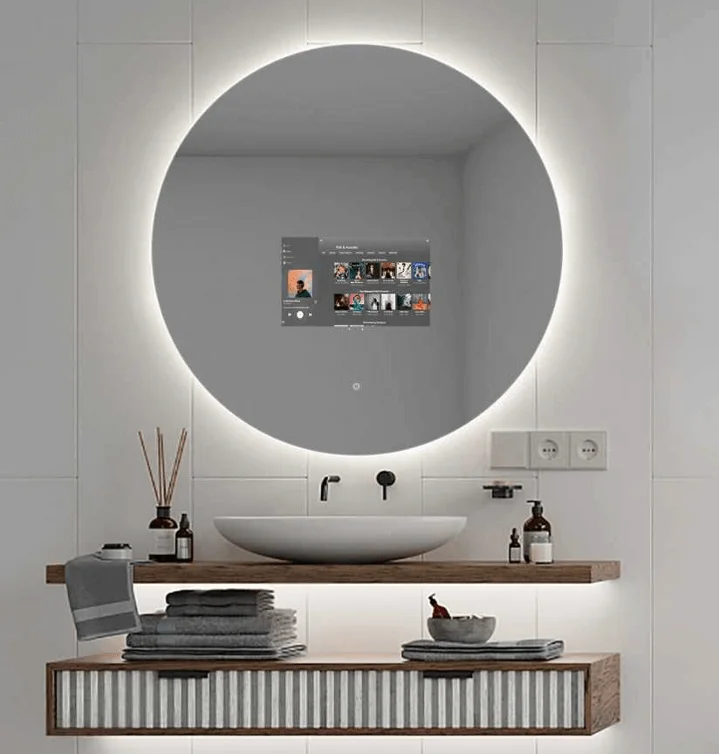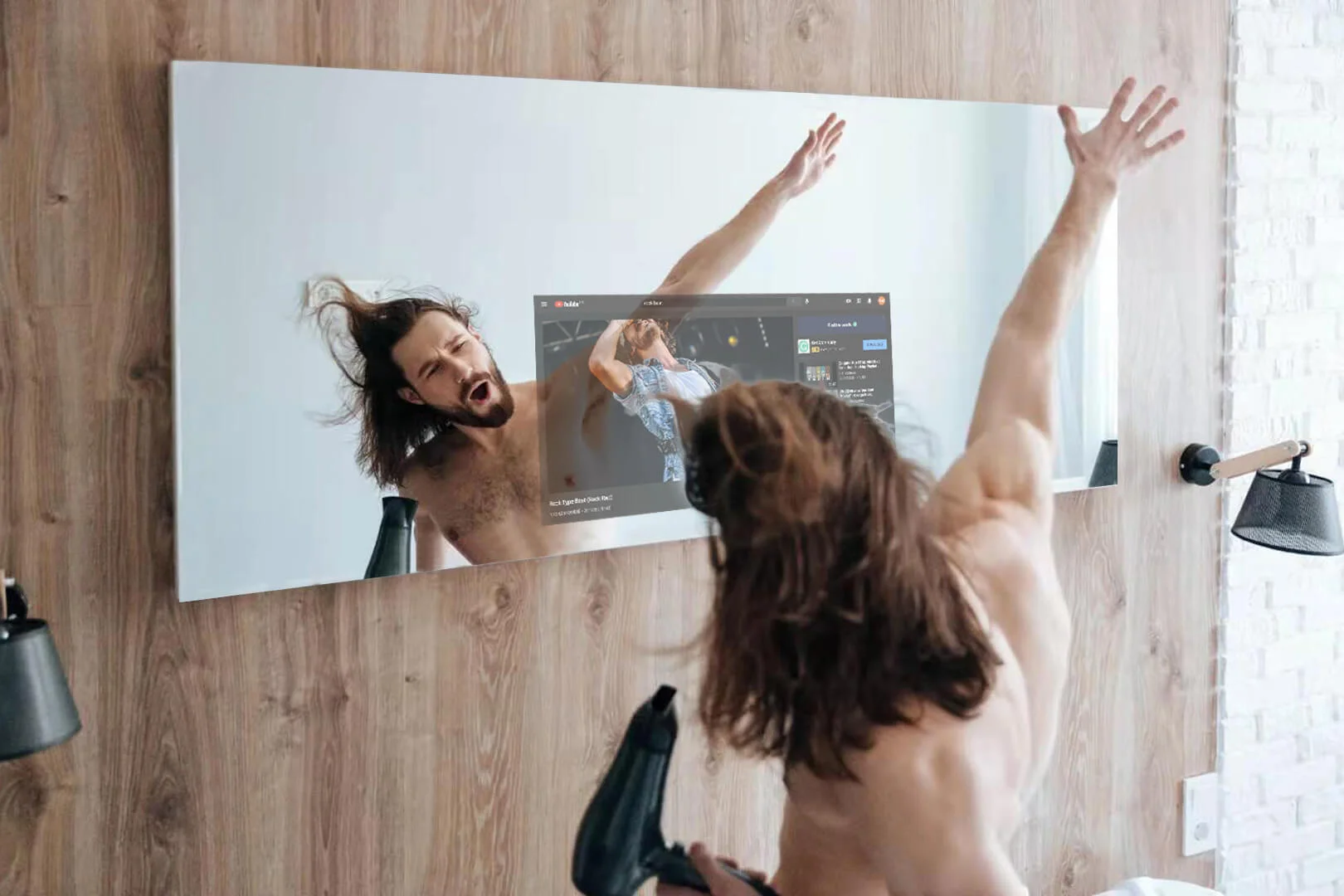What is a Smart Mirror: Complete Guide to Interactive Mirror Technology
August 15, 2025
Table of Content:
- What is an Interactive Mirror?
- How Does an Interactive Mirror Work?
- What are the Components of an Interactive Mirror?
- How Does an Interactive Mirror Enhance User Experience?
- Types of Interactive Mirrors Available
- Application of Interactive Mirrors
- What to Consider When Implementing Interactive Mirrors for Business?
- Conclusion
Smart is not just an adjective anymore. It has become a synonym for anything that improves business operations by streamlining client experiences, increasing operational efficiency, and elevating brand perception through technological integration. When corporate spaces, retail environments, and hospitality venues all seek competitive differentiation through technology, smart mirror implementation represents a high-impact, low-intrusion opportunity for business transformation.

What is an Interactive Mirror?
An interactive mirror is an innovative business asset that combines the functionality of a standard mirror with sophisticated digital display capabilities, allowing establishments to provide information, control connected systems, and enhance customer experiences while maintaining elegant aesthetics. It’s essentially a two-way mirror that presents information in the form of customizable widgets – displaying branded content, service menus, property information, personalized recommendations, wayfinding assistance, and even supporting multimedia presentations that enhance client engagement.
Digital mirrors serve multiple business functions simultaneously, acting as information kiosks, advertising platforms, and customer service tools through a single elegant installation. They can connect to existing property management systems, inventory databases, and customer relationship platforms to deliver personalized experiences based on user profiles, location context, or real-time business needs.
How Does an Interactive Mirror Work?
The technology behind a smart mirror is elegantly simple yet ingenious. It consists of three main components: a specialized two-way mirror, a digital display, and a computing system.
Unlike conventional mirrors, a smart mirror requires light to pass through from behind the glass to make the display visible. The two-way mirror maintains its reflective properties while allowing the light from the display panel positioned behind it to shine through. When the display is inactive, the device functions as a regular mirror. When activated, digital content becomes visible on the reflective surface.

A compact computer system, similar to those used in tablets or specialized devices, powers the display and connects to your home’s wireless network via WiFi or Bluetooth. This mirror connectivity enables real-time information retrieval from the internet and interaction with other smart devices in your home. The mirror interface typically offers touch sensitivity, motion sensors, or voice recognition capabilities for seamless user interaction.

Advanced interactive smart mirror models incorporate AI technologies that enhance functionality through facial recognition, personalized content delivery, and even appearance analysis for skincare recommendations or fitness tracking.

What are the Components of an Interactive Mirror
Understanding the components of a smart mirror helps appreciate the technology behind these innovative devices:
- The foundation is a specialized two-way mirror – a glass that allows light to pass through from one direction while maintaining reflective properties from the other side. MUES-TEC offers various glass options including Magic Mirror, clear glass, colored glass, and black mirror to suit different aesthetic preferences.
- Behind this specially treated glass sits a display panel, typically an LCD or LED screen that provides the visual information. Premium models feature high-resolution displays that ensure crystal-clear visuals while maintaining perfect reflection quality.
- The computing system serves as the brain of the operation, consisting of a processor, memory, and storage running a specialized operating system. Various input methods enable user interaction, including touchscreen capabilities, voice recognition, motion sensors, or cameras.
- Mirror connectivity features include Wi-Fi and Bluetooth that link the mirror to the internet and other smart devices. For audio capabilities, integrated speakers and microphones enable sound output and voice command recognition.
- Additional sensors might include temperature monitors, humidity detectors, proximity sensors that activate the mirror as you approach, or motion sensors that respond to gestures. A power management system ensures efficient energy use and protects the internal components.

How Does an Interactive Mirror Enhance User Experience?
The smart mirror changes ordinary commercial spaces into sophisticated, technology-rich environments. These mirrors impress clients and offer practical benefits for business operations.
Hotels can use interactive mirrors to show guests important property information, local recommendations, weather updates, and service menus. Guests can order services directly through interactive mirror displays. MUES-TEC hospitality mirror products enhance guest experiences with custom branding options, service menus, and entertainment features. The mirrors have adjustable settings and a premium look, which makes them perfect for luxury hotels that want to stand out.

Retail stores see major benefits from touchscreen smart mirror systems in fitting rooms. Customers can ask for different sizes, see other color options, and browse complementary items without the need to leave the changing area. Staff members can give better service with these systems. The mirrors also collect useful data about customer try-on habits and preferences.
Architects and designers now add smart mirror technology as focal points in their commercial projects. These mirrors create unique spaces with both style and practical functions. The technology in these mirrors serves as both a design element and a useful tool for the people who will use the space.
One major benefit of interactive mirror systems is how businesses can customize them. Companies can control exactly what information, brand elements, and interactive features show on their mirrors. This ensures the mirrors match specific business goals and brand guidelines.

Types of Interactive Mirrors Available
MUES-TEC’s commercial smart mirror solutions come in various specializations designed for business applications:
- Retail models focus on virtual try-ons and customer engagement, enhancing the shopping experience and reducing return rates.
- Hospitality versions provide hotel guests with information about amenities, services, local attractions, and personalized greetings, elevating the luxury experience.
- Beauty industry applications offer advanced skin analysis, virtual makeup trials, and product recommendations, making them valuable tools for salons, spas, and cosmetic retailers.
- Brand showcases create memorable interactive experiences for flagship stores and showrooms, strengthening brand identity through new technology.
- Design and architectural implementations serve as statement pieces in high-end commercial spaces, where designers and architects incorporate them as functional art that enhances spatial aesthetics.
- Distribution centers utilize specialized models for inventory management, quality control checks, and employee communication in warehouse environments.
- Elevator manufacturer partnerships integrate smart mirrors into elevator cabins to display building information, news, advertisements, and emergency notifications during rides.
- Real estate developer solutions showcase property features, provide virtual tours, and highlight neighborhood amenities in model homes and sales centers.
As technology continues to advance, commercial smart mirror applications will likely expand into additional sectors, offering innovative solutions to emerging business challenges and creating new opportunities for customer engagement and operational excellence.
Application of Interactive Mirrors
Interactive mirrors extend far beyond traditional reflection and information display, serving as versatile platforms for sophisticated business applications that leverage their unique combination of functionality and user engagement.
Virtual Concierge Services
Hospitality properties utilize interactive mirrors as virtual concierge platforms that provide 24/7 guest assistance through voice and touch interfaces. These systems can make restaurant reservations, book spa appointments, provide local attraction information, arrange transportation, and handle special requests through integration with property management systems. The virtual concierge functionality reduces front desk workload while ensuring consistent service quality regardless of staffing levels.
Health and Wellness Monitoring
Healthcare facilities and fitness centers deploy interactive mirrors with integrated health monitoring capabilities that track vital signs, analyze posture, and provide wellness recommendations. These systems can measure heart rate through facial analysis, guide exercise routines, track fitness progress, and even provide telemedicine consultations through built-in cameras and communication features. The health monitoring applications prove particularly valuable in rehabilitation centers and wellness spas.
Interactive Advertising Platforms
Retail environments leverage interactive mirrors as dynamic advertising platforms that adjust content based on user demographics, time of day, and inventory levels. These systems can display targeted promotions, demonstrate product features, enable virtual try-ons, and facilitate direct purchases through integrated e-commerce functionality. The advertising platform capabilities transform static retail spaces into responsive, personalized shopping environments.
Smart Building Integration
Modern office buildings incorporate interactive mirrors as central control interfaces for smart building systems, enabling occupants to adjust lighting, temperature, and security settings through intuitive touch and voice commands. These integrated systems can display building announcements, emergency information, and wayfinding assistance while serving as elegant architectural elements that enhance the professional environment.
AI-Powered Customer Service Kiosks
Interactive mirrors function as intelligent customer service kiosks equipped with artificial intelligence capabilities that provide instant assistance and information. In banking environments, interactive mirror kiosks help customers with account inquiries, transaction processing, and service applications while maintaining the professional appearance of traditional fixtures.

What to Consider When Implementing Interactive Mirrors for Business?
When evaluating smart mirror technology for commercial implementation, several factors deserve careful consideration:
- Business objectives. Determine precisely what operational or experiential goals the mirrors should address. Hotel implementations might prioritize guest service enhancements, while retail installations typically focus on increasing transaction values and capturing customer data.
- Installation environment. Consider the specific conditions where the mirrors will function. Spa and bathroom installations require humidity resistance, while retail mirrors need durability for frequent usage and potentially unmonitored interaction.
- Integration requirements. Evaluate how the mirror system must connect with existing business technologies including property management systems, inventory databases, or marketing platforms. Seamless smart mirror integration with operational systems maximizes ROI.
- Content management. Assess how mirror content will be updated and maintained across multiple installations. Centralized management systems significantly reduce ongoing operational demands while ensuring consistent brand experiences.
- Privacy considerations. Since many touchscreen smart mirror systems include cameras and sensors, implementing appropriate privacy protections is crucial, particularly in hospitality environments where guest trust is paramount.
- Technical support. Consider the availability of service support, particularly for businesses operating in multiple locations or in areas distant from major metropolitan centers. Responsive technical assistance minimizes potential disruption from any system issues.
- Scalability. Evaluate whether the system can expand to accommodate business growth, additional locations, or evolving technological capabilities without requiring complete replacement.
- Investment analysis. While smart mirror costs vary based on size, features, and quantities, businesses should conduct thorough ROI analysis beyond the initial purchase price. Installation, maintenance, content creation, and operational impacts all factor into the total investment consideration.
- Energy efficiency. For properties with sustainability goals or those managing utility costs across multiple installations, the power consumption characteristics of interactive mirror systems represent an important evaluation criterion.
- Warranty coverage. Carefully review protection terms, particularly for installations in high-traffic commercial environments where wear significantly exceeds residential usage patterns.
By thoroughly evaluating these factors, businesses can implement smart mirror technology that not only impresses clients but delivers meaningful operational improvements and measurable returns on investment.

Conclusion
The competitive advantages of smart mirror implementation extend far beyond aesthetic improvements. These systems deliver measurable business value through streamlined operations, enhanced client experiences, and improved staff productivity. They enable businesses to create branded information environments, collect valuable customer data, and control integrated facility systems through an elegant, space-efficient interface.

FAQ
What does a smart mirror do?
A smart mirror does much more than just reflect your image. It functions as a multi-purpose device that displays essential information directly on its surface while maintaining its reflective properties. Unlike regular mirrors, these intelligent devices show various widgets including time, weather updates, calendar events, news headlines, social media notifications, and emails – all while you’re getting ready for your day.
Is a smart mirror good for business?
Yes, smart mirrors offer significant business advantages across various industries. In retail, they increase average transaction values by allowing customers to view alternatives without leaving fitting rooms. These systems provide valuable customer behavior insights, optimize staff deployment, and strengthen brand perception. While the initial investment is substantial, the return typically justifies implementation through increased sales, operational efficiencies, and enhanced competitive positioning in the marketplace.
What are the pros and cons of smart mirrors?
Interactive mirrors offer businesses numerous advantages including enhanced customer experiences, operational efficiencies, valuable data collection, space optimization, brand differentiation, and new revenue opportunities through integrated promotion. However, they also present challenges such as significant initial investment costs, ongoing maintenance requirements, necessary staff training, complex installation needs, privacy considerations with camera-equipped systems, potential technology obsolescence, and environmental factors affecting performance. The decision to implement smart mirror technology ultimately depends on a business’s specific goals, budget constraints, and capacity to manage the technical requirements of these sophisticated systems.
How do interactive mirrors combine reflection with digital functionality?
Two-way glass technology enables these devices to display digital content while preserving reflective properties. The specialized computing system seamlessly manages transitions between mirror and display modes, ensuring users access digital features without compromising primary reflective function. This innovative approach creates unique user experiences that neither traditional mirrors nor standard displays can deliver independently.
What makes touchscreen mirrors different from regular smart displays?
Functional necessity drives user engagement with touchscreen mirrors, as people must approach these surfaces for practical reflection purposes. The guaranteed interaction eliminates the attention-capture challenges that standard smart displays face in competitive environments. Touch interface accuracy remains consistent even in humid conditions, providing reliable performance where conventional touchscreens typically fail.
What specific software capabilities do mirror touchscreens require?
Environmental adaptation forms the foundation of mirror touchscreen software, addressing moisture resistance, lighting variations, and temperature fluctuations common in commercial installations. Content management systems must handle seamless transitions between reflective and interactive modes while supporting integration with existing business platforms. Cloud-based control enables remote updates and centralized management across multiple installations without on-site technical intervention.
Which business environments maximize interactive mirror effectiveness?
Captive audience scenarios provide the most successful deployment contexts for interactive mirrors, particularly in retail fitting rooms, hotel bathrooms, and spa treatment areas. Natural user approach patterns in building lobbies, elevator areas, and service counters create optimal engagement opportunities. The combination of functional necessity and relevant digital content delivery determines implementation success more than simple high-traffic volume.
Recent articles
September 26, 2025
Touchscreen Mirror Applications: From Bathrooms to Retail SpacesSeptember 19, 2025
Digital Mirrors: Technology, Features, and ApplicationsSeptember 8, 2025
Smart Mirror Link Integration: Connecting Apps and Devices